Cats are the cornerstone of Athens
The Ohio University “Attack Cat” is unavoidable on campus, in grocery stores, and on any Ohio University merchandise from clothing to license plates. The beloved Bobcat mascot, Rufus, rolling in on a motorcycle elicits roaring excitement from football fans on game day. A pumpkin-colored cat at the Athens County Board of Elections has so much public endearment that he has his own Instagram fanpage, @pumpkin_the_cat_fanpage, which has garnered thousands of followers. Whether it be under stairs, in barns and garages, or any matter of hiding spot, cats can be found anywhere in Athens.
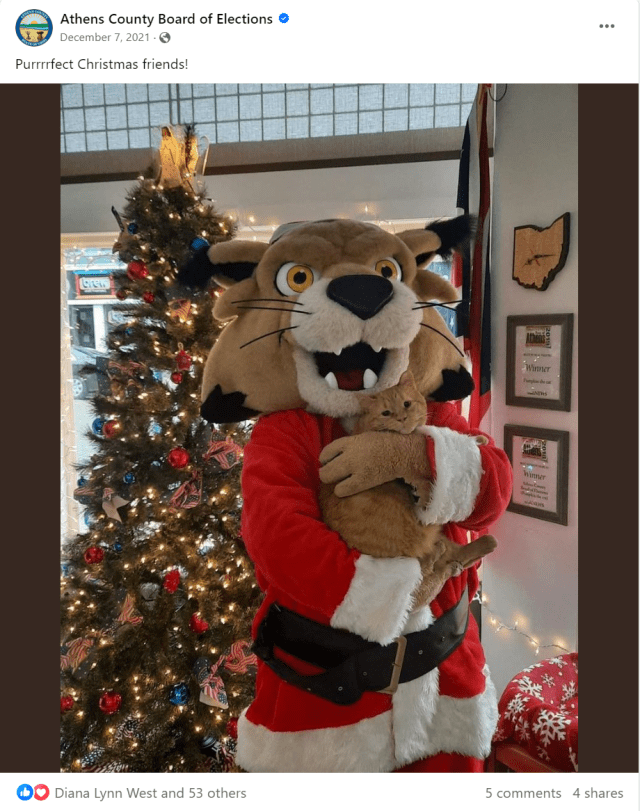
Rufus, the Ohio University Bobcats mascot, poses with Pumpkin at the Athens County Board of Elections. Photo Credit: Athens County Board of Elections, Facebook (December 7, 2021)
The problem? Cats can be found everywhere in Athens, and beyond.
Stray and feral cat colonies are pervasive in Ohio. On April 7, 2023, WBNS 10TV reported that the stray cat population in Cedarville (a village outside of Dayton) had approximately quadrupled in a year, according to a video titled “Feral cats taking over small village in Ohio” on their YouTube channel. The City of Hilliard’s website has a “Feral Cats” page dedicated to practices regarding stray and feral cat colonies. The City of Kettering has a similar page, “Stray Cats,” and Erie County wrote about stray cat policies on their “Frequently Asked Questions” page.
Humane Societies are organizations that work to end animal suffering and cruelty, care for animals in crisis, and build animal protection movements, according to the Humane Society of the United States. These organizations, like the Athens County Humane Society, are often tasked with trapping, spaying/neutering, paying for medical care, temporarily housing, and adopting out neglected and displaced cats. These organizations often are at or far beyond capacity, have long waitlists, and require intake forms, like in the case of Wayne County Humane Society in Wooster, Ohio. With cats cared for by a limited number of foster families, adoption helps lower the number of displaced cats in shelters.
Coat Color Bias Exists Throughout History
Of a sample of 2641 black cats, 74.6% faced euthanasia on their first visit to a public shelter, the highest rate of the six coat colors studied (black, brown, gray, orange, white, and “other”), according to a study published in Animal Journal. The study found black cats had the lowest rate of adoption, at 10.0%. Inversely, the study found white cats had the lowest rate of euthanasia (63.0%) and the second highest rate of adoption (18.8%) upon their first visit to a public shelter.
This data illustrates a social phenomenon called “black cat bias,” the superstition and negative association of black cats with bad luck, illness, occult, and fear. Black cats were linked to occult practices as early as the 13th century in Pope Gregory IX’s “Vox in Rama” which connected cats to Satan and witchcraft, according to History. This connection, feared by early Christians, was due to the independent attitudes and tendency to “disrespect authority” believed to be shared between women charged with witchcraft and cats, according to History. This connection likely led to the “black cat crossing your path” superstition, as few wanted to potentially cross paths with the “devil in disguise” or a witch’s familiar, according to History. In the 14th century, cats were blamed for spreading the Bubonic plague (on the contrary, cats were likely helping to contain the plague), and thus killed, according to History. In the 21st century, these residual fears are perpetuated through popular media, such as movies, and Halloween decorations.
Various world religions, ancient and current, recognized the positive connections between humans and cats, too. Christianity biblically alludes to “virtuous” cat characteristics, like strength and good judgment. For example, in Hosea 13:7 in the King James Bible, the Christian god is compared to big cats: “Therefore I will be unto them as a lion: as a leopard by the way will I observe them.” The Norse goddess of fertility, wealth, and sexuality, Freyja, rode a chariot drawn by two cats, according to the World History Encyclopedia. Ancient Egyptians famously saw cats as divine representations of deities, and cats carried important roles both in life, such as pest control, and in the afterlife, such as companionship, according to History.
Contrasted with black cat stigma, orange and white cats have largely positive associations around their coat colors. Archtypically, white represents purity, innocence, fertility, and virtue. This archetype extends to cats. Orange cats are believed to be “more friendly, more docile, and more social than cats of other colors” due to their chatty personality, according to Under the Weather, a pet wellness products company. The beliefs and biases around coat color are pervasive, and influential to cat adoption.
Coat Color Bias Affects Cat Adoptions In Athens
The Athens County Humane Society regularly utilizes its Facebook page to promote adoptable cats to residents in the Athens County area. Utilizing social media may be an effective way to persuade adoptions for cats in need. However, these Facebook posts inadvertently show the workings of coat color bias. Below are Facebook posts of adoptable male cats between three and four months old. These posts were created between August 7 and September 7, 2023. All of these posts were titled “ADOPTABLE – ATHENS OH.” Though the format of these posts is generally the same, the engagement they had varied.
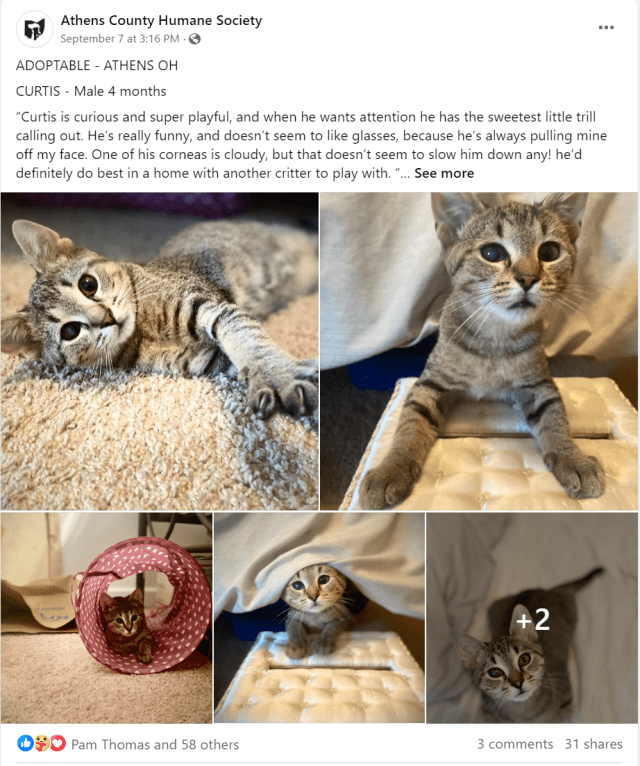
Curtis has a total of 58 reactions, 3 comments, and 31 shares. Photo Credit: Athens County Humane Society, Facebook (September 7, 2023)
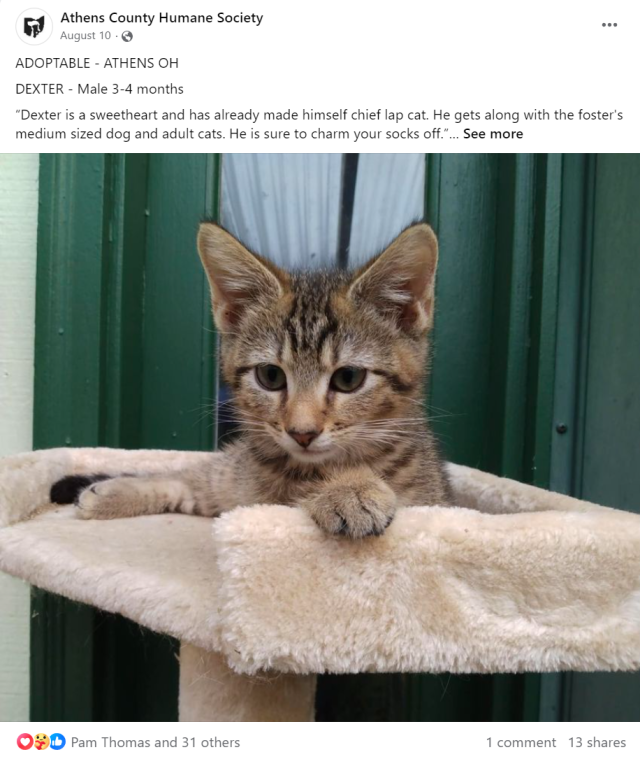
Dexter has a total of 31 reactions, 1 comment, and 13 shares. Photo Credit: Athens County Humane Society, Facebook (August 10, 2023)
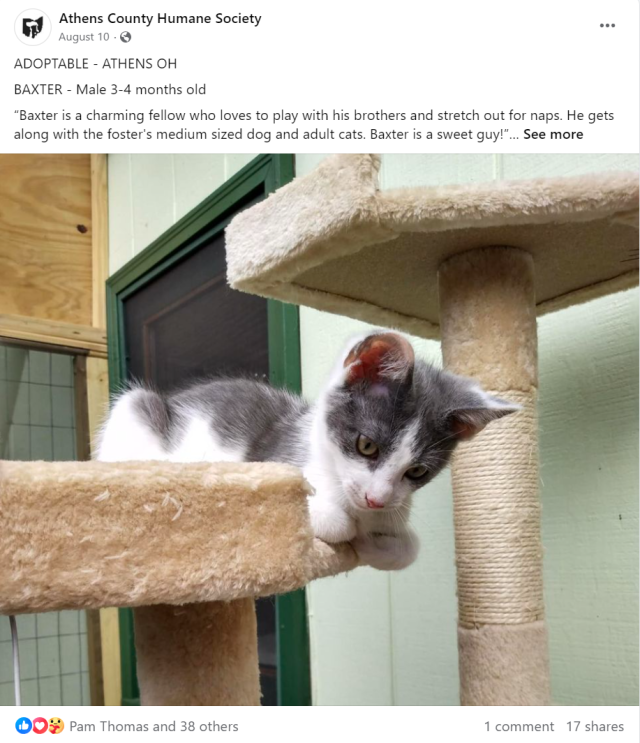
Baxter has a total of 38 reactions, 1 comment, and 17 shares. Photo Credit: Athens County Humane Society, Facebook (August 10, 2023)
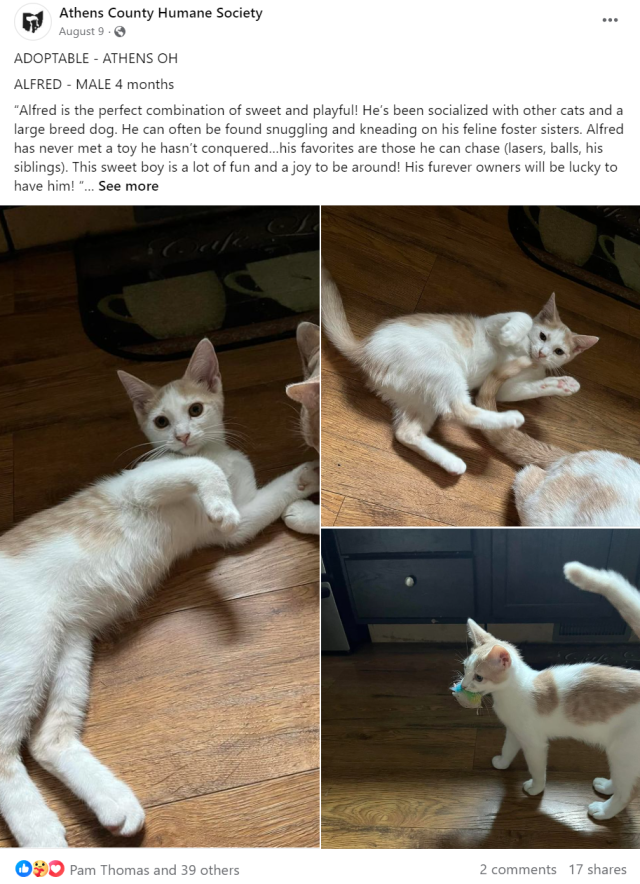
Alfred has a total of 39 reactions, 2 comments, and 17 shares. Photo Credit: Athens County Humane Society, Facebook (August 9, 2023)
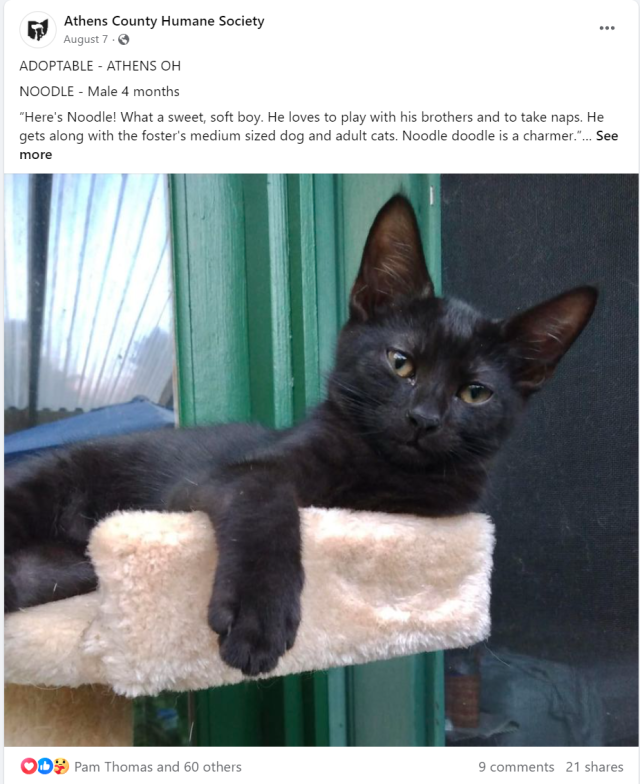
Noodle has a total of 60 reactions, 9 comments, and 21 shares. Photo Credit: Athens County Humane Society, Facebook (August 7, 2023)
The initial impression of these posts reflects that people in Athens may have little to no preference for coat color. Against the odds, the black cat, Noodle, had the highest number of interactions, comments, and shares of those posts. However, the next image shows that may not be the case because of a beloved orange cat at the Athens County Board of Elections, Pumpkin.
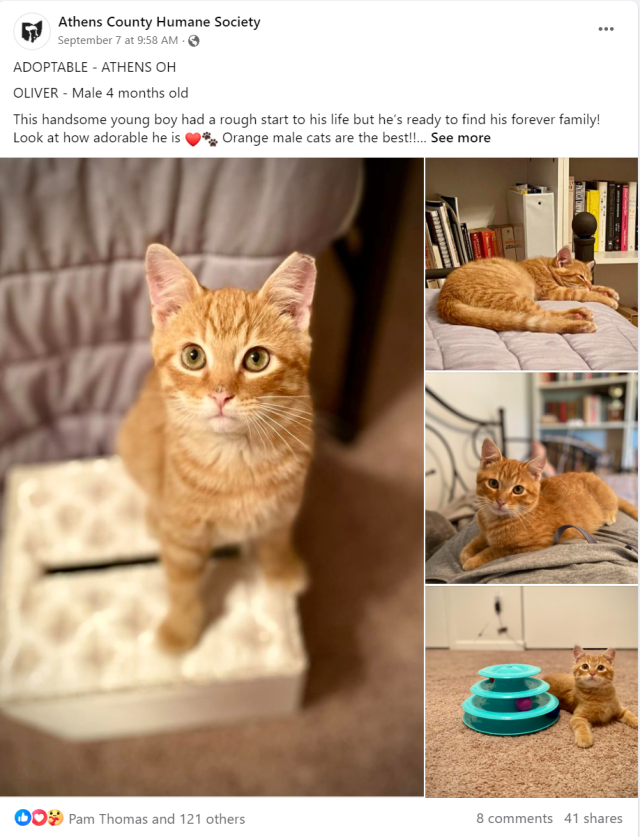
Oliver has a total of 121 reactions, 8 comments, and 41 shares. Photo Credit: Athens County Humane Society, Facebook (September 7, 2023)
Even though this post was made on September 7 with the same format, and it promotes Oliver, a cat of the same age range and sex as the others, Oliver’s post has drawn 121 total reactions, 8 comments, and 41 shares. This is approximately double the interactions and shares on Noodle’s post. This level of interaction isn’t the fault of Oliver or the Athens County Humane Society, but possibly evidence of social trends around coat color in Athens.
These posts are only a few from the Athens County Humane Society’s page, so they are unlikely to represent the entire population of Athens cat lovers. However, these posts may indicate the larger trends in Athens, such as the popularity of adopting Pumpkin look-alikes. These trends most likely affect which cats people choose to adopt or to pass over.
Every cat deserves the comforts of home life and family. However, the color of their coats may impact their likeliness to be adopted before potential adoptees ever meet them in person. Cats are found everywhere in Athens, but depending on the color of their coats, they may be found in shelters more than others.
To see adoptable cats or to submit an adoption application to the Athens County Humane Society, visit this website.


